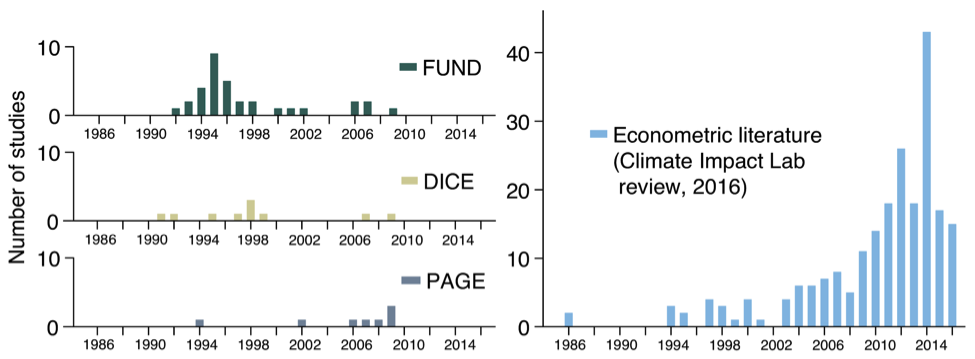An article by James Rising*
Grantham Research Institute on Climate Change and the Environment, London School of Economics
*The article has been published on the new EAERE magazine. The EAERE Magazine is an outlet for new research, projects, and other professional news, featuring articles that can contribute to recent policy discussions and developments in the field of environmental and natural resource economics. It will be published quarterly in the Winter, Spring, Summer, and Fall. Astrid Dannenberg, University of Kassel, Germany is the EAERE Magazine Editor. Contributions from the wider EAERE community, especially senior level researchers and practitioners, and Country Representatives, are featured in the magazine.
Research on the impacts of high temperatures has evolved quickly over the past decade. Recent econometrics research has exposed causal relationships between high temperatures and mortality, labor productivity, agricultural yields, energy demand, economic growth, and many other areas, and these analyses are getting more sophisticated every year. Higher resolution climate projections have helped translate these relationships for future populations, producing empirical estimates of the costs of climate change. While most current methods miss the potential of adaptation, rapid research is testing new techniques that try to handle adaptation.
Enlarge

Estimates of the global cost of climate change used in policy have evolved much more slowly. Climate, the economy, and policy are brought together in Integrated Assessment Models, or IAMs. Three of these, FUND, DICE, and PAGE, are used by the U.S. Environmental Protection Agency to evaluate the costs and benefits of regulation in light of climate change impacts. A recent literature review by the Climate Impact Lab found that most of the parameters used to inform FUND and DICE are over 20 years old. The fact that the EPA continues to use only these models, despite the emergence of several new models, is another indication of regulatory inertia. The future of the process of costing climate change depends on bringing research and policy closer together.
Our recent paper published in Science sets out a new vision for bringing this research in empirical environmental economics to bear on social policy [1]. First, it lays out criteria for the kinds of studies that are appropriate for large-scale impact forecasting. These include the intuitive argument that the studies should be representative of the entire area being projected; based on data valid for real-life circumstances (rather than lab settings); and estimate causal, rather than correlative, relationships. Second, it argues that the full extent of uncertainty – in both climate changes and economic parameters and responses – be represented. And third, that we build systems that can continue to be updated as new science comes out. A key tool in this process is meta-analysis: the process of synthesizing multiple studies. Our paper relies on the Distributed Meta-Analysis System [2] to combine estimates, and maintain a library of results for the future.
Resolution matters for identifying the costs of climate change too. Older IAMs computed uniform damages across large segments of the world, but climate affects us where we are, and different groups have very different outcomes to look forward to. The PESETA II project to estimate climate impacts in Europe found a distinct north-south gradient, placing harsher damages on some of the poorer European countries [3]. A similar pattern exists in the United States, and we found that this results in welfare losses over twice the monetary losses, producing the equivalent of over 10% losses in GDP by the end of the century.
Enlarge

The future of climate impact damages should focus on these improvements: a greater commitment to empirical grounding and the uncertainty that comes with it, more comprehensive and nuanced estimates, and higher resolution impacts and their consequences for different groups. But the future of the costs of climate change is more than better research of its physical and financial impacts.
The U.S. EPA under Scott Pruitt has recently made a troubling change in how it accounts for the costs of climate change. Since 2010, the U.S. government has accounted for the impacts of climate change through a global “social cost of carbon” (SCC), which is the total loss to all countries from an extra ton of CO2. This corresponds to the optimal carbon tax to address the externality of CO2-driven climate change, estimated at $42 for CO2 released in 2020 under a 3% discount rate [4]. In October, the EPA quietly swapped this global SCC for a domestic SCC, accounting only for the costs to the U.S. economy [5]. Under this accounting, a ton of CO2 costs only $6.
Even for a domestic SCC, this number may be far off. Our domestic accounting of the costs of climate change in the U.S. translates to a $23 per ton cost, and it only accounts for six kinds of impacts that have been empirically estimated (in order of potential impact: mortality, labor productivity, energy expenditures, yields of four crops, coastal property damage, and crime). If the empirical U.S. results are an indication, the global costs may be 4 times current estimates. Since our estimates are for a rich, temperate country, impacts for poorer, hotter areas are sure to be greater and their welfare consequences greater still.
The discussion in Europe hinges less on the value of the SCC, muddying the use of this work in the European context. While the SCC can inform carbon taxes, the comprehensive price for an optimal cap-and-trade system needs a different estimate. This is the “shadow price of carbon” (SPC), which is the price the marginal emitter would pay to emit an additional ton of CO2. The shadow price is determined by the costs of abatement, rather than damages. If the SCC says how costly climate change is, the SPC says how costly mitigating it (e.g., to 2° C) will be. Under an optimal climate policy, the two numbers become the same.
Empirical estimates of the SPC are hard to produce, because of the lack of information on the true costs businesses face. However, the challenge is not so different from inferring the costs and potential of adaptation for an SCC: it requires comprehensive models, high resolution, recognition of uncertainties, and systems that are designed to update as new science emerges.
Finally, the SCC and SPC are far from exclusive or contradictory. The full economic costs of climate change encompass the costs of impacts, the costs of mitigation, and the costs of adaptation (another key area of research in our field). These are the three key relationships that modellers of IAMs need to generate better numbers and inform policy. In this way, the empirical work I have focused on here is also not in conflict with the development and improvement of IAMs. Bringing our field together can close the information gap and reveal our prospects for the future.
*James Rising is an interdisciplinary modeler at the Grantham Research Institute
on Climate Change and the Environment at the London School of Economics.
His research is on the feedbacks between environmental and human
systems, focusing on the impacts of climate change and the water-energy-
food nexus. Prior to joining GRI, James held postdoctoral positions at the
Energy & Resources Group at UC Berkeley and the Energy Policy Institute at
the University of Chicago. He received his Ph.D. from Columbia University’s
program in Sustainable Development.
For further information:
[1] Hsiang, S., Kopp, R., Jina, A., Rising, J. (2017). Estimating economic damage from climate change in the United States. Science, 356 (6345), 1362-1369.
[2] The Distributed Meta-Analysis System
[3] Ciscar, J. C., et al. (2014). Climate impacts in Europe -The JRC PESETA II project.
[4] Technical Update of the Social Cost of Carbon for Regulatory Impact Analysis
[5] Regulatory Impact Analysis for the Review of the Clean Power Plan: Proposal
For further information, read the EAERE magazine no. 1 – Spring 2018






